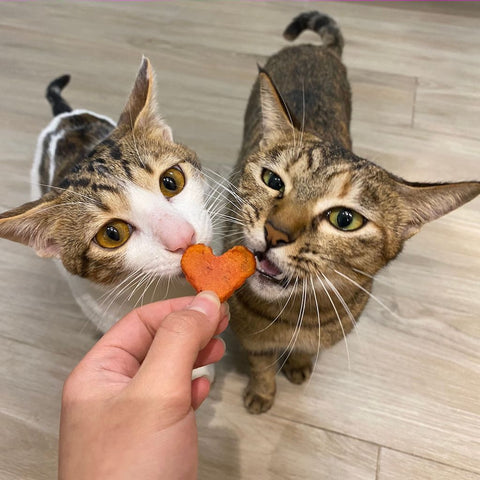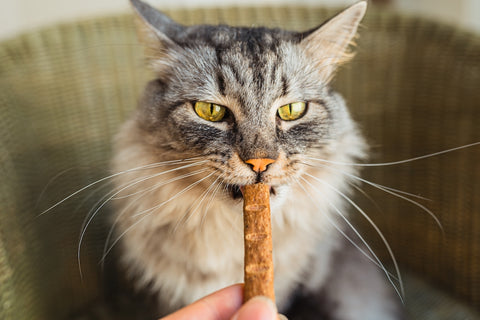Cat not eating food but eats treats
If your cat's refusing their regular food but still munching on treats, it can be a cause for concern. Here’s a breakdown of possible reasons and what you can do about it.
When Fluffy Prefers Treats: Understanding Cat Eating Habits
Exploring Causes and Solutions for Feline Picky Eating Habits
1. Health Issues
Dental Problems: Pain while chewing regular food might discourage eating, but treats are often easier to consume.
Digestive Problems: Discomfort or nausea can make regular food less appealing.
Underlying Health Conditions: Issues like kidney disease or diabetes might affect appetite.
2. Food Preferences
Texture or Flavor: Your cat might have developed a preference for the texture or taste of treats.
Change in Diet: If you switched their food recently, they might be rejecting it.
What Can You Do?
Consult a Vet: Rule out health issues first.
Food Rotation: Try different flavors or textures of their regular food.
Gradual Transition: Mix treats into their regular food to encourage eating.
Dental Checkup: Ensure their teeth are healthy.
Limit Treats: Minimize treats to encourage interest in regular meals.
Temperature: Warm their regular food slightly to enhance aroma.

When to See a Vet
If your cat's refusal to eat persists for more than 24-48 hours, or if accompanied by other concerning symptoms like lethargy, vomiting, or diarrhea, a vet visit is essential.
A cat's reluctance to eat regular food while enjoying treats might stem from various reasons, from health issues to preferences. Understanding their behavior and ruling out health problems through a vet visit is crucial. Experimenting with their diet and making gradual changes might help regain their interest in regular meals.
Common Causes of a Cat's Preference for Treats Over Food
A cat’s preference for treats over regular food can stem from various factors:
Texture and Taste Preference: Treats often have different textures and flavors that cats find more appealing than their regular food. Cats can become accustomed to the strong flavors and textures of treats, leading them to favor them over their regular meals.
Addictive Nature of Treats: Some treats are intentionally designed to be highly palatable and may contain ingredients that entice cats and create a craving. This can lead to a preference for treats over regular food.
Feeding Routine: If treats are given inconsistently or in place of regular meals, cats might start expecting treats as their primary source of food, leading to a reluctance to eat their usual meals.
Health Issues: Cats may have underlying health issues that affect their appetite. Dental problems, gastrointestinal issues, or illnesses can cause discomfort when eating regular food but not necessarily with treats, leading to a preference for treats.
Attention and Reinforcement: Cats might associate treats with positive attention from their owners. If treats are given as rewards for behavior, cats might prefer them due to the associated attention or reinforcement.
Environmental Factors: Changes in the environment, stress, or anxiety can affect a cat’s appetite and preference for certain foods or treats. They might seek comfort in familiar treats rather than regular food during stressful situations.
Spoiling Behavior: If a cat is consistently given treats upon demand, they might refuse regular food in favor of treats due to learned behavior.
Tips and Tricks to Manage Your Feline Friend's Dietary Preferences
Cats can be quite particular about their food preferences. Here are some tips and tricks to manage their dietary needs:
Understanding a Cat’s Dietary Preferences:
Protein-Centric Diet: Cats are obligate carnivores, so their diet should primarily consist of animal-based proteins.
Texture Matters: Some cats prefer wet food over dry food due to its higher moisture content and different texture.
Tips to Manage Dietary Preferences:
Gradual Transition: When changing their diet, do it gradually over a week to avoid digestive upset.
Variety: Offer a variety of flavors and textures. Rotate between different types of wet and dry food to keep them interested.
Meal Schedule: Establish a regular feeding schedule to maintain their routine.
Fresh Water: Ensure there's always fresh water available. Some cats prefer running water, so a fountain might be appealing to them.
Avoid Human Food: Refrain from feeding them human food, especially items that are toxic to cats like chocolate, onions, garlic, etc.
Consult a Vet: If you’re concerned about their preferences affecting their health, consult a vet for guidance on suitable options or supplements.

Handling Picky Eaters:
Patience: Don’t force them to eat a certain food. Cats may refuse to eat if they feel pressured.
Food Warm-up: Warming up refrigerated food slightly can enhance the aroma and make it more appealing.
Food Puzzles: Use puzzle feeders or toys that dispense food to make mealtime more engaging and stimulating.
Hand-Feeding: Sometimes, hand-feeding or offering small amounts of treats can encourage a cat to try new foods.
Treats for Encouragement: Use treats made from high-quality ingredients as rewards for trying new foods.
Health Check: If there’s a sudden change in appetite or dietary preferences, it might signal an underlying health issue. A vet check-up is advised.
Special Dietary Needs:
Allergies or Sensitivities: Some cats may have allergies or sensitivities to certain ingredients. Identify and avoid triggers.
Weight Management: For overweight cats, portion control and weight management diets might be necessary.
Senior Cats: Older cats might require specialized diets to cater to their changing nutritional needs.
Remember, each cat is unique, so what works for one might not work for another. Observing their behavior and preferences will guide you in managing their dietary requirements effectively.
Leave a comment
